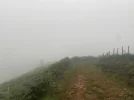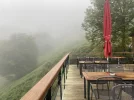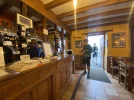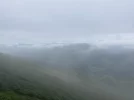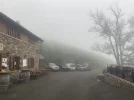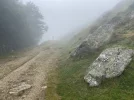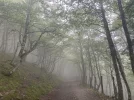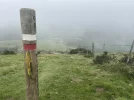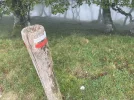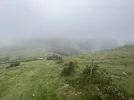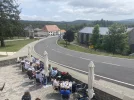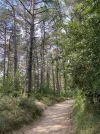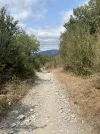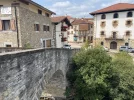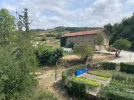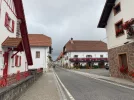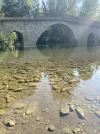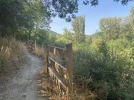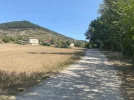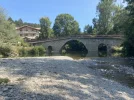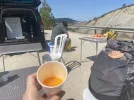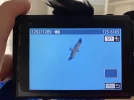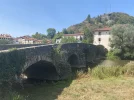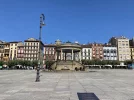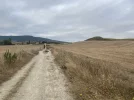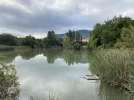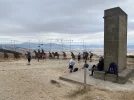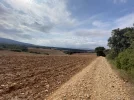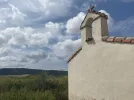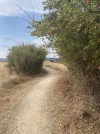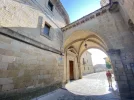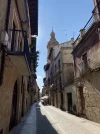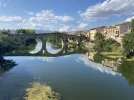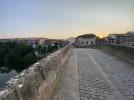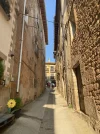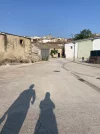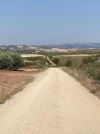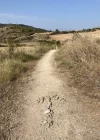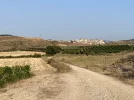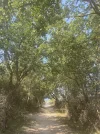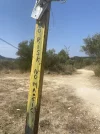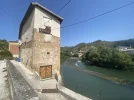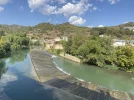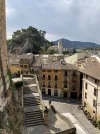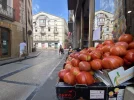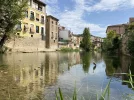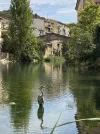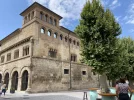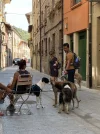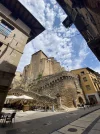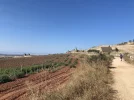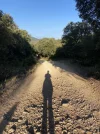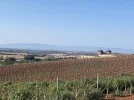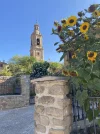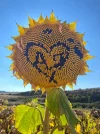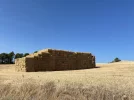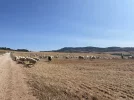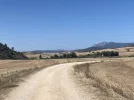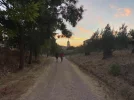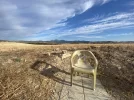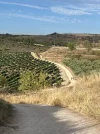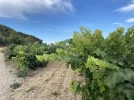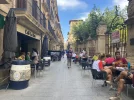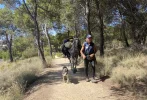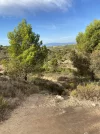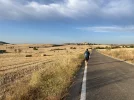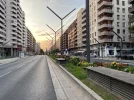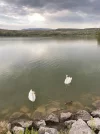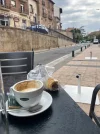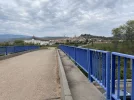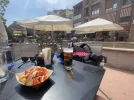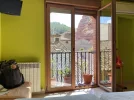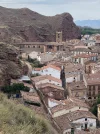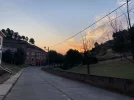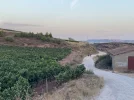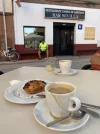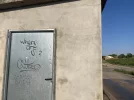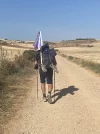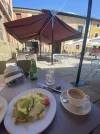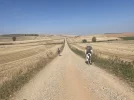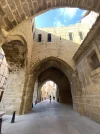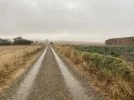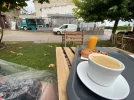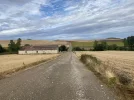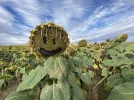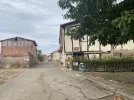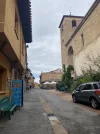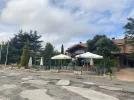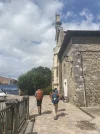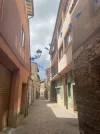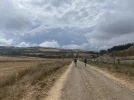First, I’m sorry that my final update is so delayed…
I’ve never known a storm like the one that hit Santo Domingo de la Calzada the night before our last day of walking. I’ve seen some intense storms in various countries, but never a lightning storm that lingered in one place for nine hours. As I mentioned in my last post, we’d got lucky with a booking at the main Parador on the Plaza España by the cathedral. It was originally a little luxury which I’d found for a surprisingly cheap rate during one of the lockdowns. That booking was at the Parador’s recently opened hotel in the town, the Fresneda. They then closed that hotel during Covid, and moved all bookings to their other one on the plaza. Somehow we ended up with a balcony overlooking the square, directly opposite the bell tower. The bell tower is fascinating for many reasons but one of these is that it’s the highest point in the town, with commanding views that are well worth the climb (note from experience: it’s best not to lean back to take photos when the bells are about to chime

). By around 10:30pm, I heard a light patter of rain, which surprised me given that the day and evening had been glorious. I went out onto the balcony and brought in my socks. I then drifted toward sleep. At around 11pm, I shot upright when there was an almighty crash. It shook the room, accompanied by a brilliant flash. Lightning had struck the bell tower. Of course it had. The storm then passed over a little but the lightning continued until long after we were awake and packing for the day. I delayed for a while, reading posts here and on other sites about walking during lightning storms. There is a difficulty in not knowing personally the land ahead: whether there will be flat plains in which a walker will be the sole high point, where lighting is most likely to strike; whether there will be many bare hilltops. I read about the lightning crouch, and theories about when and whether it’s a good idea to lie flat on the ground. Over the hour, we watched three pilgrims cross the plaza, each of them in sturdy ponchos. By 8am, the lightning seemed to be less frequent. I’d had a chat with the concierge, who told me that the storm was coming from the west, which was of course where we were heading. This meant that we should be walking away from it rather than into it. We shook out our disposable ponchos and left the hotel in a persistent but undemanding rain. We saw no more lightning. Walking down the main road, we avoided a flooded section of the Camino. We couldn’t see the surrounding hills because of fog. Reaching the cross that marks the historical duel through which a standoff between Grañón and Santo Domingo was resolved—for years, there had been disagreement about the ownership of a pasture field—the clouds lifted. Entering Grañón, we followed the sound of piano music: Einaudi, one of my favourites. What a haven is the cafe van Barbackana! We ordered two of the breakfasts, which comprised what we usually order anyway: cafe con leche, a warm neopolitana and fresh orange juice. I chatted with the owner in Spanish; a really kind, friendly man. Gradually, more pilgrims appeared. We talked with a lady from Indiana who is still on the Camino. Four American friends also joined the group; they’d split their stages differently from us so it was lovely to catch up with them. The air was suddenly fresh. We sat beneath bright-leafed trees, piano drifting among us, taking group photos. We left Grañón with our new friend, the lady from Indiana, with whom we’d walk the rest of the day to Belorado. Vultures appeared above us in squadrons, released from the storm. We stopped in Viloria, having been greeted by a car that pulled over: two locals who handed us cool bottles of water because ‘it’s the four year anniversary’ of St James. What a lovely gesture! The village is also the birthplace of Santo Domingo. We went into the Church of Nuestra Señora de la Asunción, where there is a 10th century font. Inside, I talked with a volunteer and inhabitant of the village. It was a meeting that will stay with me. All her life, she’s watched pilgrims walk through the village and not stop, perhaps not knowing that it is the birthplace of Santo Domingo. The ruins of his house are still there, with a sign explaining that they are ‘more than ruins’. There are hotels in the town and restaurants that are usually open but had to close because of Covid. There is an application to open a museum in the village, and the Ayuntamiento is in talks with higher political powers about developing the village so that its significance can be better understood. The lady I spoke with was passionate, ‘Muy triste’, she kept saying, and I found myself agreeing that is was sad. I wanted to hug her. Moving on, we stopped at a somewhat peculiar but pleasant restaurant in Villamayor Del Río: peculiar because of the combination of warning signs, not to wear backpacks, not to remove shoes, that the wifi was overloaded so they’d turned it off, to maintain distance, etc, all in a narrow entrance next to a 19th century style pram full of frilly dolls. Pleasant because the outside area was airy and bright, and the waiter helped me to load a tray full of food and drinks so it was balanced well. The food consisted mostly of egg products because they have their own hens, but with some sandwiches, which we ordered. More pilgrims arrived and we chatted with a man from Barcelona who’d become a very familiar face. Now a group of four, we walked the remaining stretch into Belorado under a deep sun, vultures still gliding overhead, the conversation carrying us forward so that we were in Belorado, and at the end of our Camino, before we could feel saddened.
Afterward, we explored Belorado. The foot and hand prints of famous people embedded into the pavement, including Emilio Estévez and Martin Sheen. The leafy central square. The views from the castle to places we wouldn’t this year reach. The abandoned stork nests.
Somehow, somewhere in Belorado between Hostal B and the bus stop, I lost my ring. It’s silver, with a gold plated circular disk and a round lapis lazuli set into it. I bought it in Crete and loved it. If anyone sees it, I’d love to be reunited with it. I’m also oddly accepting of its loss to me, though. I thought I’d removed all my rings before we left for Spain, and was surprised to see it still on my hand in the airport, like a stowaway. I felt it was destined for something. It makes sense that it’s meant to be with someone else now.
The following day, we took a bus part way to Burgos, got off in the middle of nowhere and walked two hours to Paleolítico Vivo (
https://www.paleoliticovivo.org), to do one of their jeep safaris. Very odd, after the Camino, but somehow also coherent: how humans lived alongside nature for so many millennia. I strongly recommend visiting this place if you have time.
After that, we explored Burgos, and the following day drove to Barcelona. We then had a full day and a half day in the city before flying home.
It is a shock to be back here. I’m not enjoying the need to be static. We wish our work lives were such that we could complete the Camino in one go.
What next? We plan to return next May/June and pick up where we left off. I’m currently looking into flights to Madrid, a train to Burgos, bus to Belorado, then… as many sections as we can manage. I will prebook rooms again. There are few flights from northern Spain to northern England so we’re looking at trains back to Madrid from as far west as our time will allow. My plan is also to improve my Spanish further before then.
I wonder where any of this leads. The Camino strikes me as natural, organic, our bodies doing what they are designed to do but also fighting to become that strong, our minds finding equilibrium. And yet it is miles from reality, for most of us. How do we balance these competing demands? I don’t know. Maybe more Camino will teach me. Maybe not!
I’d love to know your own experiences: of doing only a chunk of etapes, of the adjustment afterwards, of doing the full Camino and how that felt after, or of anything I’ve touched on here.
Thanks for reading

 ) and we were supposed to do a small section of the Frances in September 2020. We postponed that to May 2021, lengthening the section to Burgos. We postponed it from May again, to now.
) and we were supposed to do a small section of the Frances in September 2020. We postponed that to May 2021, lengthening the section to Burgos. We postponed it from May again, to now.














